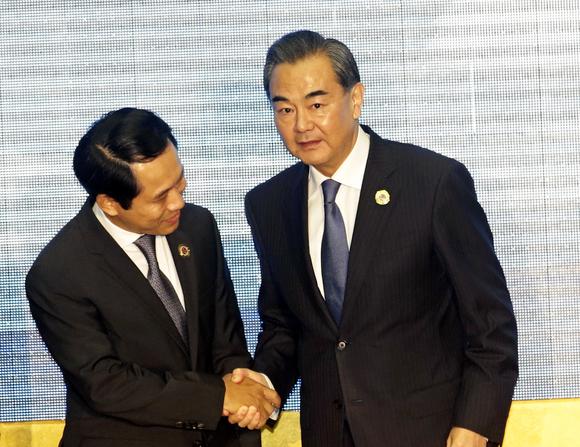Laos, which is seen as pro-Beijing, has been showing some diplomatic savvy. Late on the night of July 24, Laotian Foreign Minister Saleumxay Kommasith showed up at the hotel that Chinese Foreign Minister Wang Yi was staying at here in the country’s capital.
On the face of it, there appeared to be nothing unusual. Wang also met Aung San Suu Kyi, Myanmar’s state counselor and foreign minister, as well as other foreign ministers in the international conference hall.
But it was unusual. It was Wang who summoned his host country’s foreign minister to the hotel.
While the dynamic looks distinctly like a revival of the Imperial Chinese tributary system, it is also a relationship Laos has no choice but to accept.
Thailand is the source of most of Laos’ imports, but China is No. 2. Going the other way, China is the top buyer of Laos’ exports.
Many Laotians carry around smartphones made by Huawei Technologies. Much of the country is air-conditioned by Gree Electric Appliances. The most handsome building in the capital is a branch of the Industrial and Commercial Bank of China.
Wang was in Vientiane to attend an Association of Southeast Asia Nations (ASEAN) Regional Forum meeting of foreign ministers. His intention was to get his peers to recognize China’s claim over most of the South China Sea — a claim rejected earlier in July by an arbitration tribunal in The Hague.
China was trying to wield some high-handed diplomacy. Wang, who shared his Beijing-Vientiane flight with North Korea’s foreign Minister, said he also wanted to ask his South Korean counterpart, Yun Byung-se, about South Korea’s latest defense posture.
Beijing-Seoul relations have deteriorated since South Korea said it would deploy the U.S.’s Terminal High Altitude Area Defense system. The THAAD deployment comes in reaction to North Korea’s continued missile launches.
But landlocked Laos, surrounded by five countries, including China, seems to have the skills to survive the region’s tugs of war.
These skills could be seen at the ASEAN ministerial meeting, where the host managed to include this phrase in the joint communique despite China’s opposition: “We further reaffirmed the need to … pursue peaceful resolution of disputes in accordance with international law.”
In the statement from the ASEAN Regional Forum’s chairman, Laos stated parties should “pursue peaceful resolution of disputes … in accordance with international law, including the 1982 United Nations Convention on the Law of the Sea (UNCLOS).” A senior Japanese foreign ministry official said he gives Laos full marks for its performance.
So while Laos, by necessity, leans toward China, it is also maintaining balance. There is architectural evidence of this: Japan built Laos’ airports. China constructed its international conference hall. And South Korea laid the boardwalks along the Mekong River here in the capital. The multilingual signs at these places stand in testament to Laos’ diplomatic savvy.
Source: Nikkei Asia Review



